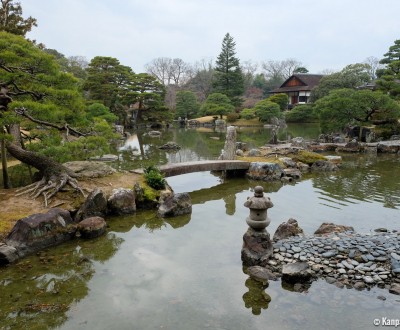Katsura
The Imperial Villa in Southwest Kyoto
Katsura Imperial Villa is a former princely residence of the Hachijo family, located in the southwest part of Kyoto’s city center. Classified as an "Important Cultural Good of Japan," this house-garden has been a source of inspiration and architects study it as an example since the 20th century. Visits (only with advance reservations) are warmly recommended every year, especially during koyo season.
Built in 1615, the complicated domain was laid out across two generations, spanning several decades, and was completed in the middle of the 17th century. Close to the imperial power, the Hachijo-no-Miya lineage built into the area makes it a truly alive masterpiece where green spaces and different pavilions are perfectly matched. The hosts logically chose this location, close to the Katsura River and not far away from the Kokedera Moss Temple, as we can easily observe the moon. Several indoor (for example, the Gepparo) and outdoor (around the pond) observation points favor this lunar contemplation.
Discovering Katsura Villa is like a temporal escape to search for the purest Japanese aesthetics. The visit starts with a feeling of dispossession, notably when we go across the imperial entrance, made of a simple wood gate. Then, as we go on the path across the garden, we progressively dive into a fine universe where each element has been neatly thought to make an undisputedly beautiful landscape. Whether you are an amateur art historian or a curious visitor, the landscape will not leave you cold, and you will live this experience with eyes and ears wide open.

Just like at its cousin Shugakuin, your place has to be booked an hour in advance at the Imperial House Agency. The guided tour lasts about one hour, in a group of about 20 people. Walking at the front, the guide gives oral information while another staff person follows the group at the end. Photographs are allowed during the walking tour but not on the stone bridge due to the risk of falling. We stop at the outside facades of the main building, which remains closed, but we can see the inside of the Shokintei tea pavilion. The modern equipment is surprising; for example, the blue and white tiles surprise us, as compared to the traditional thatched roof. We recommend wearing stable shoes as the paths are stone and could be slippery.
Since November 1, 2018, admission requirements changed to allow a larger capacity. The visit has a fee for adults but is free for children from 12 to 17 years old (children under 12 are unfortunately not accepted). The number of tours has increased from six to 24 tours a day, including five in English. An audio guide is available in other languages, with simpler explanations, to complete the visit in Japanese.

